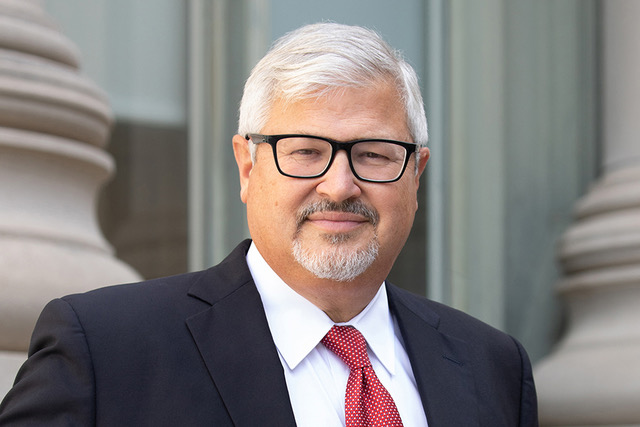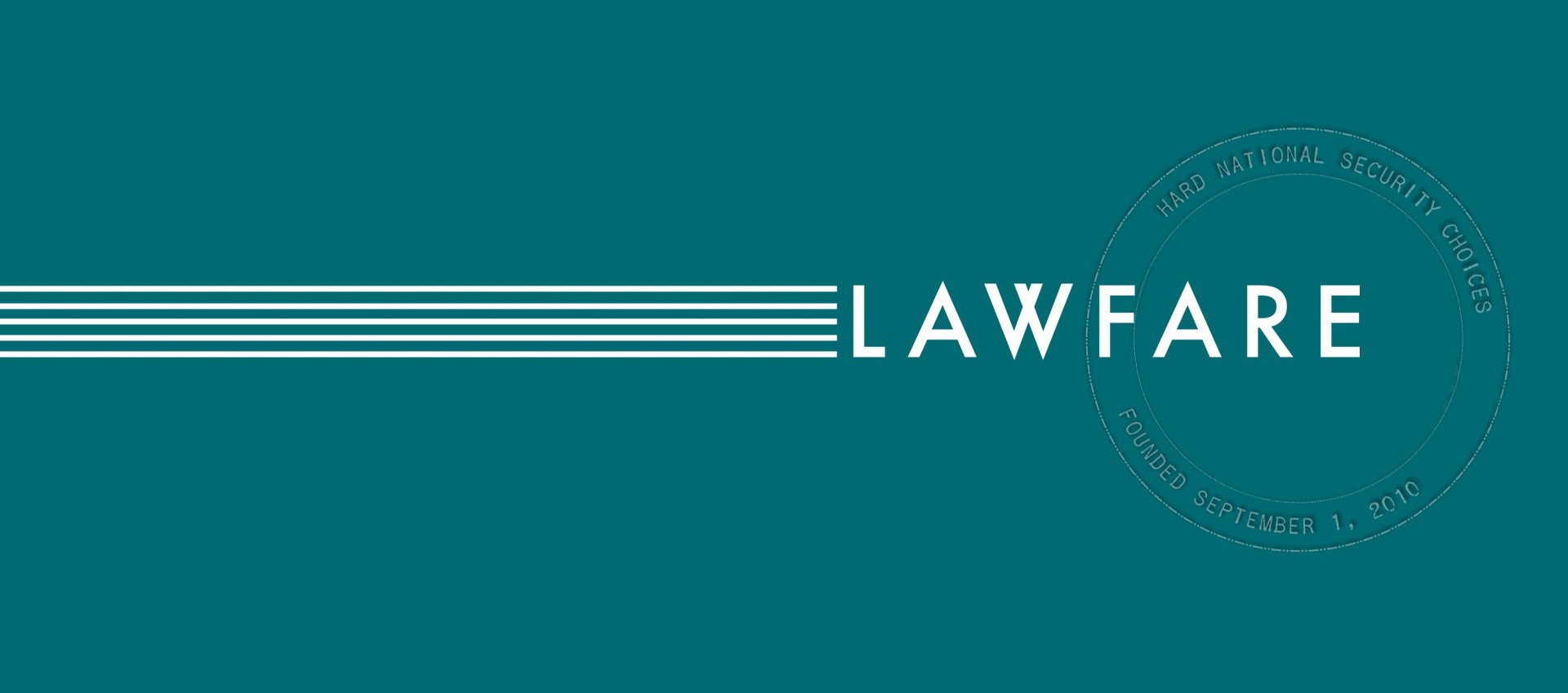OLC’s Meaningless 'National Interests' Test for the Legality of Presidential Uses of Force
The Justice Department’s Office of Legal Counsel (OLC) published a legal opinion May 31 that explained the basis for its oral advice in April that President Trump had the authority under Article II of the Constitution to direct airstrikes against Syria.
Published by The Lawfare Institute
in Cooperation With

The Justice Department’s Office of Legal Counsel (OLC) published a legal opinion May 31 that explained the basis for its oral advice in April that President Trump had the authority under Article II of the Constitution to direct airstrikes against Syria. The office concluded that the action was constitutional because it advanced three “national interests” identified by the president: “the promotion of regional stability, the prevention of a worsening of the region’s humanitarian catastrophe, and the deterrence of the use and proliferation of chemical weapons.” It further reasoned that nothing in Article I of the Constitution affected this conclusion.
In this post we first explain why, for most unilateral presidential uses of force, OLC’s “national interest” test is the only relevant one. We then show why this test provides no meaningful constraint on presidential power.
Background
In its Syria opinion, OLC applied the same two-part framework that it had invoked in a 2011 opinion that concluded that the Obama administration’s airstrikes against Libya were constitutional. The first part of the framework asks “whether the President could reasonably determine that the action serves important national interests.” OLC deems this inquiry into national interests constitutionally relevant because, under current OLC doctrine, “Article II provides the President with the authority to direct U.S. military forces in engagements necessary to advance American national interests abroad.”
The second part of the framework identifies the one possible constitutional limit on the president’s unilateral authority to use force abroad in the national interest. According to the Syria opinion, the declare-war clause and Congress’s authority to fund military operations “oblige the President to seek congressional approval prior to contemplating military action that would bring the Nation into a war.” But not every unilateral military operation rises to the level of war. Whether a unilateral military operation constitutes a “war,” and thus requires congressional authorization, depends on the “anticipated nature, scope and duration” of the conflict.
Importantly, as OLC noted in the Syria opinion, only “prolonged and substantial military engagements, typically involving exposure of U.S. military personnel to significant risk over a substantial period,” are likely to constitute wars that require congressional authorization. Modern presidents, however, rely heavily on drones, manned airstrikes, and other short-term or relatively limited “fire from a distance” as their principal mechanisms for using force abroad. For such actions, the second part of OLC’s framework will not be a source of constraint.
Indeed, the Libya and Syria episodes make clear how extensively a president can use force from the air without requiring congressional authorization under OLC’s nature/scope/duration test, even when these operations potentially have long-term foreign policy consequences or pose risks of escalation. The Libya operation cost more than $1 billion, involved thousands of air sorties, and drove a foreign leader from power. The Syria operation was significantly smaller in scale and duration, but it was potentially more dangerous, and arguably threatened greater escalation, because U.S. troops have had a presence in Syria and Russia is a Syrian ally that also has a presence in Syria. As OLC acknowledges in its Syria opinion, it has “found that previous military deployments did not rise to the level of a war even where the deployment was substantial.” And it reports that when it was asked about the proposed Syria operation, it concluded that the operation fell “far short of the kinds of engagements approved by prior Presidents under Article II.” (Emphasis added.)
For these reasons, in the vast majority of cases today in which a president wants to use force without congressional authorization, any constraint in OLC’s two-part framework would need to come from the first part of the framework, which considers whether “national interests” support such force.
The Origins and History of the 'National Interests' Test
One might wonder how the presence of national interests in using force abroad is even relevant to the separation-of-powers question of whether the president must obtain congressional authorization before using force. One hopes, of course, that the president (and the nation) would use force only if it reasonably appears to be in the national interest to do so. But whether a particular use of force promotes U.S. interests would seem to be a policy question rather than something relevant to the question of presidential power.
To be sure, it may be possible to conclude—as a result of structural inferences from the Constitution or historical practice—that presidents can use force to address particular national interests, such as protecting Americans abroad who are threatened. And OLC has often connected its discussion of national interests to historical precedent. The Syria opinion quotes a 1970 OLC opinion concerning Cambodia for the proposition that “[s]ince judicial precedents are virtually non-existent” in defining the scope of the president’s war powers, “the question is one which of necessity must be decided by historical practice.” Such practice, OLC contends in its Syria opinion, “points strongly in one direction,” and it notes that “by the middle of the twentieth century, scholars had identified well over 100 instances of military deployments without prior congressional authorization.”
But the fact that presidents have used force abroad unilaterally in many circumstances does not, by itself, show that they can do so whenever “national interests” support it. It may well make sense to allow historical practice to serve as a “gloss” in discerning the scope of the president’s war powers. Some practices, however, are likely to be more established than others, and if the issue is historical practice the chief inquiry should be the nature of that practice, not abstract inquiries into the national interest. Nevertheless, OLC has come to view past uses of force as mere illustrations of a general presidential authority to use force to protect national interests, whatever those interests might happen to be. Here are some highlights from that history:
The national-interests test appears to have originated in dicta in Attorney General Robert Jackson’s 1941 opinion, Training of British Flying Students in the United States, 40 Op. Att’y Gen. 58 (1949). The issue there was whether the president had authority under the Commander in Chief Clause to authorize members of the U.S. Army Air Corps to train British flying students. In determining that he did, Jackson reasoned in broad terms:
Article II, section 2, of the Constitution provides that the president “shall be Commander in Chief of the Army and Navy of the United States.” By virtue of this constitutional office he has supreme command over the land and naval forces of the country and may order them to perform such military duties as, in his opinion, are necessary or appropriate for the defense of the United States. These powers exist in time of peace as well as in time of war.
That broad statement was enough to cover the issue at hand. But Jackson went further and said: “Indeed the President’s authority has long been recognized as extending to the dispatch of armed forces outside of the United States, either on missions of good will or rescue, or for the purpose of protecting American lives or property or American interests.” (Emphasis added.)
A second important precursor to the national-interests test was a throwaway line in the State Department’s opinion in support of President Truman’s unilateral use of force in North Korea in 1950. The Truman administration justified the president’s authority to use force in large part on the need to uphold the integrity of the young U.N. Charter as well as the U.N. Security Council resolutions supporting force in Korea. Part of the State Department’s explanation for the use of force in Korea was that “[t]he continued existence of the United Nations as an effective international organization is a paramount United States interest.” (Emphasis added.)
The Jackson opinion and the State Department line would be relied on in the opinion that first crafted the modern national-interest test: OLC’s 1992 opinion upholding the president’s authority under Article II to commit U.S. forces to assist the United Nations in ensuring the safe delivery of food and medicine in Somalia. After alluding to historical practice, OLC concluded “that the President has the power to commit United States troops abroad for the purpose of protecting important national interests.” It cited one Justice Department precedent for this proposition: the “American interests” reference in Jackson’s British Flying Students opinion. It also invoked dicta from the Supreme Court’s decision in United States v. Verduqo-Urquidez (1990), which stated that “[t]he United States frequently employs Armed Forces outside this country—over 200 times in our history—for the protection of American citizens or national security.” OLC then relied on these materials and the line from the Korea opinion to identify two “national interests” that justified the use of force in Somalia: protecting the lives of Americans overseas and upholding the recent United Nations resolutions regarding Somalia. OLC did not provide criteria for the identification of national interests supporting presidential uses of force or explain how many of what kinds of interests would suffice.
The next major decision in this line was the 1994 OLC opinion in support of the president’s authority under Article II to introduce U.S. ground troops into Bosnia and Herzegovina to help NATO ensure compliance with a peace agreement. Relying heavily on the Somalia opinion and citing the Jackson dicta, OLC concluded that the president had the legal authority under Article II “to order the deployment, in order to further important national interests.” The national interests identified in the opinion were “preserving peace in the region and forestalling the threat of a wider conflict” and maintaining the credibility of NATO decisions.
Another opinion in this line was written by one of us (Goldsmith) in 2004 when he headed OLC. It concerned the deployment of U.S. troops into Haiti to protect American citizens from violence there. Building upon the opinions above, the opinion identified three interests that justified the deployment under Article II: (1) protecting American citizens and property, (2) preserving regional stability and (3) maintaining the credibility of the United Nations.
The Libya opinion was the next major opinion in this series. This appears to be the first time that OLC expressly separated its analysis into two discrete inquiries: a national-interest test and the nature/scope/duration inquiry. Based on the opinions above, OLC had little trouble concluding that “the combination of at least two national interests that the President reasonably determined were at stake here—preserving regional stability and supporting the UNSC’s credibility and effectiveness—provided a sufficient basis for the President’s exercise of his constitutional authority to order the use of military force.”
Then came last week’s Syria opinion, which, as noted above, justified the use of force based on the identification of three national interests: “the promotion of regional stability, the prevention of a worsening of the region’s humanitarian catastrophe, and the deterrence of the use and proliferation of chemical weapons.” The latter two interests were new in published OLC opinions. The Syria opinion noted, however, that an earlier, unpublished Obama OLC opinion had recognized “the U.S. interest in mitigating humanitarian disasters.” And the Syria opinion itself was the occasion for recognizing the interest in deterring chemical weapons use. OLC acknowledged that it was “unaware of prior presidents justifying U.S. military actions based on this interest as a matter of domestic law,” but it concluded that reliance on such an interest was “consistent with those that have justified previous uses of force.” It then cited the United States’ long-standing opposition to use of chemical weapons in concluding that “the United States has a weighty interest in deterring the use of these weapons.”
Critique
There are number of problems with the national-interest test as it has come to be applied by OLC. First, OLC provides no criteria for determining which interests qualify. Unsurprisingly, therefore, its framework provides no limiting principle. Nor does OLC supply any standard for assessing how many interests must exist, or in what degree, to support unilateral presidential action. As a result, any plausible interest articulated by a president is likely to satisfy the test. Once OLC recognizes an interest in one opinion, it will suffice in the next. Moreover, as in the Syria opinion, OLC has little trouble recognizing new interests that will suffice. And the interests that it has recognized are extraordinarily broad, especially the interest in promoting regional stability, which will invariably be present when a president wants to use force. OLC essentially concedes this point in its Syria opinion, observing that “[t]hese interests ... give the President a great deal of discretion.”
More fundamentally, OLC is almost certainly not in a position to second-guess presidential claims about the national interest. Both the Libya and Syria opinions essentially deferred to the president’s determination that using force was in the national interest. If the president misjudges U.S. national interests when using force, there of course may be political consequences, but OLC does not have the information, expertise or authority to make such an assessment. Put another way, there is nothing at all in OLC’s analysis that would permit it to reject an asserted interest by the president in using force, at least absent overwhelming and unambiguous evidence that the interest was pretextual, and probably not even then. OLC in the Syria opinion effectively acknowledges these points as well, observing that the national-interest inquiry is “a question more of policy than of law” and that it “would not expect that any President would use this power without a substantial basis for believing that a proposed operation is necessary to advance important interests of the Nation.”
In sum, the national-interest test provides no meaningful legal check on the president and certainly not one that OLC could enforce. What this ultimately means is that, in evaluating the constitutionality of presidential uses of force, OLC is really employing a single test. That test is whether the use of force, based on its anticipated nature, scope and duration, constitutes a “war.” If not, then the president can, under OLC’s analysis, constitutionally use force without congressional authorization. And, as discussed above, the nature/scope/duration test imposes very little constraint on modern presidential uses of force.



-final.png?sfvrsn=b70826ae_3)

